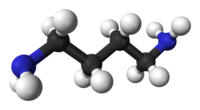
Photo from wikipedia
L-valine is a valuable amino acid in mammals that is used as the main component of feed additives. The low efficiency of the fermentation titer limits the industrial application of… Click to show full abstract
L-valine is a valuable amino acid in mammals that is used as the main component of feed additives. The low efficiency of the fermentation titer limits the industrial application of L-valine. Here, an L-valine-producing strain of Escherichia coli was obtained using a multi-modular strategy. Initially, a chassis strain was generated by mutagenesis and high-throughput screening. The L-valine biosynthetic pathway and transport module were modified to improve the L-valine titer. Subsequently, the transcription factors associated with L-valine biosynthesis were investigated. Overexpression of PdhR and inhibition of the expression of RpoS promoted L-valine synthesis. Finally, the NADPH supply was enhanced after the introduction of the heterologous Entner-Doudoroff (ED) pathway from Zymomonas mobilis. The strain VAL38 produced 92 g/L L-valine in a 5-L bioreactor with a yield of 0.34 g/g glucose. This strategy is provided as a reference for improving the production performance of cell factories for L-valine and its derivatives.
Journal Title: Bioresource technology
Year Published: 2022
Link to full text (if available)
Share on Social Media: Sign Up to like & get
recommendations!